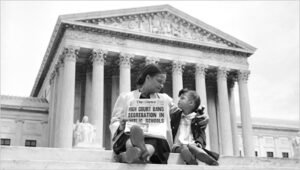
Military-age males are a dangerous, scary lot. Best to have as few of them around, as possible. I should know. I used to be one myself.
In recent months, GOP politicians and other immigration restrictionists have been sounding the alarm about the presence of large numbers of "military-age males" among migrants crossing the southern border. There is no justification for such alarmism. "Military-age male" migrants don't pose any special danger. Indeed, they are, on average, less dangerous than native-born citizens of the same description. Nor is there any reason to be much concerned about the fact that this group may be overrepresented among illegal migrants.
The definition of "military-age male" isn't clear. But, most likely, it refers to men between the ages of about 18 and 45—the age group that includes most military personnel. If so, it's not surprising that illegal migrants may be disproportionately drawn from this category. After all, most migrants are fleeing poor and repressive societies in hopes of finding greater freedom and opportunity. For obvious reasons, men in their prime working years are more likely to migrate in search of employment than children or the elderly.
In addition, illegal migration often involves risks created by participation in an illegal market. Undocumented migrants may be victimized by criminals, detained in awful conditions by US authorities, or suffer other dangers. On average, men are far more risk-acceptant than women. Thus, it isn't surprising that they are more likely to be willing to risk the dangers of illegal migration. If you want to increase the proportion of women and children among migrants, the best way is to make legal migration easier, thereby making the process much less dangerous.
That said, the disproportion between men and women in the illegal migrant population is far from overwhelming. The Migration Policy Institute estimates that women make up 46% of the US undocumented immigrant population. That's only modestly lower than their proportion of the overall US population (about 51%). And, far from seeing a surge in the percentage of single males among undocumented immigrants, 2023 actually saw an increase in the percentage of undocumented migrants who come in family groups.
One concern about military-age male migrants is the fear that they might be terrorists. But the number of people killed in terrorist attacks in the United States perpetrated by illegal migrants who crossed the southern border from 1975 to the present is zero. Either the incidence of terrorists among males who cross the southern border is extremely low, or they are extremely bad at committing actual acts of terrorism. Male undocumented migrants actually have a substantially lower incidence of terrorist attacks than native-born citizens do.
There is also no good evidence that military-age male migrants are somehow agents of foreign military forces, planning an invasion. Being a military-age male doesn't mean you are likely to be a member of any actual military force or have any military skills. Similarly, the fact that younger males are, on average, better basketball players than women and older men, doesn't mean that most young men are actually professional basketball players, or have more than rudimentary playing skill. Calling them "basketball-age males" doesn't change that reality. I have criticized the "invasion" narrative in more detail here.
There is one kernel of truth to concerns about military-age males: men, especially young men, have a much higher crime rate than women do. They commit a hugely disproportionate percentage of violent and property crimes. For example, in 2019, according to FBI data, men accounted for almost 89% of those arrested for murder, and just under 97%of those arrested for rape.
However, if you worry about undocumented military-age males for this reason, you should worry about native-born ones even more. That's because undocumented immigrants have much lower crime rates than native-born Americans do. In Texas between 2013 and 2022, for example, undocumented immigrants (2.2 homicides per 100,000 people per year), are about 36% less likely to commit homicide than native-born citizens (3.0 per 100,000 per year). And that's without controlling for age and gender. If you do control for those variables, the gap between undocumented immigrants' and natives' crime rates becomes even larger, due to the greater proportion of younger males among the former.
Obviously, in any large group, there are going to be some dangerous individuals. The point is not that military-age male migrants are risk-free (they aren't!), but that the incidence of that risk is low.
Conservatives rightly condemn left-wingers who claim all men are potential rapists. While the incidence of rape by men is vastly higher than that by women, the vast majority of men are not rapists and never will be. The same reasoning applies to right-wing scaremongering about "military-age male" migrants. Stigmatizing a large group based on the crimes of a small minority is wrong. And that's especially true if the group's overall crime rate is actually lower than that of comparably situated members of the rest of the population (in this case, male native-born Americans).
In sum, there is nothing surprising or sinister about the relative overrepresentation of "military-age males" among undocumented immigrants. And these men are actually, on average, less dangerous than native-born Americans of the same age and gender.
Obviously, there are many rationales for immigration restrictions and harsh border policies unrelated to fear of military-age males, or even to crime and terrorism, more generally. Some are more defensible than fear of military-age males. I have tried to address many of them in other writings, such as my book Free to Move: Foot Voting, Migration, and Political Freedom. Here, I hope to help clear away a bad argument, so we can devote more attention to better ones.




Show Comments (22)